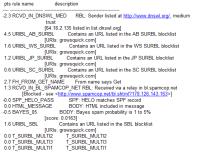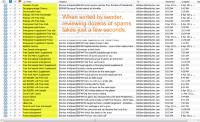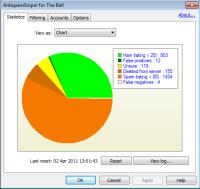Alien Skin. Eye Candy 6. Fun.
I could probably stop with the title. If you're already familiar with Alien Skin, you know about Eye Candy. You may know that a new version has been in the works for a while. You know just how seriously this company takes amusement. But bear with me for a moment and let's look at the latest from this North Carolina company.
Alien Skin Software makes Photoshop plug-ins for photographers and graphic designers. In their own words, they "distill advanced math and cutting-edge research into simple tools that render beautiful pictures." I couldn't have said that better.
Eye Candy includes 30 filters with more than 1000 presets and hundreds of controls. Complex and hard to use? Of course not! This is Alien Skin, the company that hides all of this power behind a surprisingly simple user interface. Presets are organized into categories and each adapts to fit the size of the current image. If you want to explore beyond the presents, that's easy. And after customizing an effect, you can save your own settings for re-use.
 Let's see what we can do with a photo of Chloe and Perseus (aka "Percy") lying on the bed. This is the image I started with. I added a bit of text.
Let's see what we can do with a photo of Chloe and Perseus (aka "Percy") lying on the bed. This is the image I started with. I added a bit of text.
 Here I've called Eye Candy into action with a patriotic backlight filter. This effect doesn't do much for the image in my estimation but we've only just begun.
Here I've called Eye Candy into action with a patriotic backlight filter. This effect doesn't do much for the image in my estimation but we've only just begun.
 I like this one. It's a standard bevel effect with a stone effect on the text. But let's see what else we can find.
I like this one. It's a standard bevel effect with a stone effect on the text. But let's see what else we can find.
 Chrome is cool. Alien Skin gives you a nice variety of interior and exterior scenes that are reflected in the chrome, too. But I'll keep trying.
Chrome is cool. Alien Skin gives you a nice variety of interior and exterior scenes that are reflected in the chrome, too. But I'll keep trying.
 Oooh! Psychedelic! This is the corona effect. By itself, it doesn't work with this image but it might work in combination with other effects.
Oooh! Psychedelic! This is the corona effect. By itself, it doesn't work with this image but it might work in combination with other effects.
 Spray paint? Hmm. Not by itself.
Spray paint? Hmm. Not by itself.
 Here's an extrusion effect that is cool but not what this image needs.
Here's an extrusion effect that is cool but not what this image needs.
 Flames? Maybe, but cats generally don't like fire.
Flames? Maybe, but cats generally don't like fire.
 Glass! I love the glass effect. And this is just one of several preset effects or hundreds of options that you can create on your own.
Glass! I love the glass effect. And this is just one of several preset effects or hundreds of options that you can create on your own.
 Gradient glow may remind you of the corona effect. It's not for this image, though.
Gradient glow may remind you of the corona effect. It's not for this image, though.
 Or maybe the text might grow some icicles.
Or maybe the text might grow some icicles.
 Look at this! It's a perspective drop shadow. Because the text is 3 decks tall, the shadow won't be the same for each deck. At the bottom you would expect a hard shadow. The second and third decks are further above the surface so the shadows should be different, softer. And they are.
Look at this! It's a perspective drop shadow. Because the text is 3 decks tall, the shadow won't be the same for each deck. At the bottom you would expect a hard shadow. The second and third decks are further above the surface so the shadows should be different, softer. And they are.
 Or maybe the words are smouldering and about to catch fire ....
Or maybe the words are smouldering and about to catch fire ....
 Final image? Maybe. Here I've combined the bevel/stone effect, fire, and smoke. It's up to the user to decide which Eye Candy effects to use, in what combination, in which stacking order, and with what opacity settings for each layer.
Final image? Maybe. Here I've combined the bevel/stone effect, fire, and smoke. It's up to the user to decide which Eye Candy effects to use, in what combination, in which stacking order, and with what opacity settings for each layer.
And this is just an example of Eye Candy's Text and Selection options. You'll find an equal number of options under Textures. These effects, instead of affecting selections or text, apply to the full image.
Eye Candy supports 16-bit/channel images and CMYK mode and both of these features are important for professional users. The application also recognizes and takes advantage of multi-core CPUs. Even so, some of the filters are so complex that processing is not immediate. That's to be expected when you're applying an effect to a gigantic raw image. And Eye Candy 6 supports the 64-bit version of Photoshop.
 Bottom Line: As usual, Alien Skin has a winner here.
Bottom Line: As usual, Alien Skin has a winner here.
Digital image manipulation is complicated and involves some complex math functions. Alien Skin takes care of all that for you and you'll need to deal with an interface that allows you to specify how much of which effect you want to apply. After that, Eye Candy does all the heavy lifting.
For more information, visit the Alien Skin website.
Killing Spam by Allowing Spam
Some Internet service providers and many site hosting services, such as Bluehost, give you the option of running Google's Postini antispam service. It may be free or it may cost a few dollars per year per account. Either way, it's not a good value. If you have a high-speed connection, it makes sense to download all messages and cull the spam on your computer.
That is the exact opposite of the process I've used for many years.
Postini seemed like a good choice because it's trainable and it also allows for both blacklists and whitelists. Unfortunately, that turned out to be my primary complaint about how Postini works.
- You can whitelist addresses, but Postini may still hold a message from the whitelisted address and claim that it's spam. I send myself a copy of the weekly TechByter bulletin to confirm that it went out on time and about half the time the bulletin ended up being classified as spam. Why? I whitelisted the address.
- You can blacklist addresses, but Postini doesn't delete messages from that address. Instead, it places them in the "held" area. So even though I know that I never, ever want to read a message from FreeBizMag.com, I still had to manually delete every message they sent. Why? I blacklisted the address.
When I enabled Postini, I disabled SpamAssassin. SpamAssassin is an old application that uses vigilante blacklists along with user-definable blacklists and whitelists. It also has a long list of rules by which it ranks messages. Any message with a rating higher than a number the user selects is considered spam and, optionally, SpamAssassin with rewrite the subject line with a term the user chooses.
I set SpamAssassin to consider any message with a rating of 5 or higher to be spam and that's a fairly aggressive setting. Combined with my whitelist and blacklist, I've found this to be a workable setting. No matter how low a message's score, it will be marked as spam if the address is on my blacklist; no matter how high a message's score, it will not be marked as spam if the address is on my whitelist.
 The rating system will add points when an included URL is listed in one of several block lists and will deduct points for factors such as the sending address's presence in the DNSWL.org's whitelist. If SpamAssassin considers the message to be spam, "IBSPAM" is added to the subject line.
The rating system will add points when an included URL is listed in one of several block lists and will deduct points for factors such as the sending address's presence in the DNSWL.org's whitelist. If SpamAssassin considers the message to be spam, "IBSPAM" is added to the subject line.
As e-mail is downloaded, Norton Internet Security examines it, too, and marks suspected messages with "[Norton Anti Spam]". The next step will ignore both SpamAssassin and Norton Anti Spam. That's because SpamAssassin is my second line of defense and Norton Anti Spam is third.
The next step is Anti Spam Sniper for The Bat (also available for Outlook, Outlook Express, Windows Mail, and Windows Live Mail). Anti Spam Sniper has its own internal whitelist and blacklist that are specified by the user. Additionally you can specify rules (allowing, for example, any message that contains a valid PGP-encrypted signature or disallowing any message with an empty "from" line or a date that's in the future). The plug-in comes with its own rules but you can write you own using regular expressions.
As with most antispam systems, Anti Spam Sniper rates messages, but then it goes one step further: For messages in the "uncertain" zone (by default those with a rating between 20 and 85) Anti Spam Sniper uses Cloudmark's SpamNet online database for additional information.
In the first week, 803 messages were classified as good and 1456 as bad. Anti Spam Sniper recorded 12 false positives and 4 false negatives. Those are both remarkably low numbers and they improve over time as the user identifies mistakes to the program.
 Anti Spam Sniper uses its own Junk folder for spam and I sort that folder alphabetically by sender because this allows a quick review of the contents for false positives. I also look for messages that don't have either "IBSPAM" or "[Norton Anti Spam]" in the subject line because those might be false positives (although usually they're not).
Anti Spam Sniper uses its own Junk folder for spam and I sort that folder alphabetically by sender because this allows a quick review of the contents for false positives. I also look for messages that don't have either "IBSPAM" or "[Norton Anti Spam]" in the subject line because those might be false positives (although usually they're not).
 My e-mail program has a robust flittering system that kicks in after Anti Spam Sniper performs its evaluation and I use that filtering system to sort any message that contains "IBSPAM" or "[Norton Anti Spam]" into Trash but leave it marked as unread. Whenever an unread message appears in Trash, I check to see if it's a message that Anti Spam Sniper missed. This happens infrequently, at most once or twice per day, and I then mark the message as Junk so that Anti Spam Sniper will recognize similar messages.
My e-mail program has a robust flittering system that kicks in after Anti Spam Sniper performs its evaluation and I use that filtering system to sort any message that contains "IBSPAM" or "[Norton Anti Spam]" into Trash but leave it marked as unread. Whenever an unread message appears in Trash, I check to see if it's a message that Anti Spam Sniper missed. This happens infrequently, at most once or twice per day, and I then mark the message as Junk so that Anti Spam Sniper will recognize similar messages.
I've found this process to be considerably faster and easier than having to deal with the server-based Postini. All messages come to my computer and they are quickly sorted as good messages (ham) or bad messages (spam) with 99.4% accuracy.
 Bottom Line: Separating ham from spam has never been easier.
Bottom Line: Separating ham from spam has never been easier.
If you use The Bat (or Outlook, Outlook Express, Windows Mail, or Windows Live Mail) and you detest spam, you'll find Anti Spam Sniper to be a worthwhile addition to your defenses. A free version omits some features; the shareware version works without restrictions for 30 days, and when you're ready to buy, it's just $20.
For more information, visit the Anti Spam Sniper website.
Short Circuits
Kindle. Libraries. File under: It's About Time!
One of my primary complaints about the Kindle, although I like the device itself, has been Amazon's wrong-headed approach to library books: Unless you were willing to break the digital rights management (DRM) on library books, loading them on your Kindle wasn't possible. Amazon finally has seen the light.
Kindle Library Lending will launch later this year and will allow users of any Kindle device to borrow books from more than 11,000 libraries in the United States that use Overdrive to provide digital content. Kindle Library Lending will work on all generations of Kindle devices and Kindle reading apps.
According to Amazon, the Kindle Lending Library will work within the existing OverDrive framework, but neither company has been willing to share any technical details. Competing readers allow users to borrow library books but Amazon has refused to go along until now.
Digital books work like their physical counterparts: If the library licenses 5 copies of a book, only 5 people can read it simultaneously. One of those people must check the book back in (or allow it to expire) before a 6th person can check it out. Unlike physical books, though digital copies can't be lost, damaged, or kept by the borrower.
And Then There Were Three
Last month Western Digital announced plans to purchase Hitachi's hard disk unit and now Seagate is planning to acquire Samsung's hard disk manufacturing business. The disk business isn't as profitable as it once was and manufacturers are consolidating even as the demand for standard hard drives continues to increase. Eventually it will decline.
Many portable devices use solid-state memory to replicate a disk drive. The solid-state devices aren't as sensitive to vibration and shock (although if you hit them hard enough they will break).
Just a few months ago, 5 relatively large and robust disk manufacturers were competing for worldwide business. With these changes there will be only 3 so regulators in the US and the EU will undoubtedly be looking closely at the deal. Samsung will provide chips for Seagate products and Seagate will provide disk assemblies for Samsung products.
Seagate will buy Samsung's hard drive business for $1.38 billion in cash and stock and Samsung will acquire just under 10% of Seagate's shares. The combined company will have about 40% of the market. Western Digital/Hitachi have about 40% of the market. That leaves Toshiba with about 20% of the market.
At one time, an estimated 200 hard drive manufacturers existed worldwide. Remember any of these: Alps, Conner, Control Data, Data General, Digital Equipment Corporation, Epson, Fujitsu, IBM, Iomega, JVC, Micropolis, MiniScribe, NEC, Quantum, Tandon, Texas Instruments, or Wang? [Source for list: Wikipedia]
Online Poker: Don't Bet On It Says the DOJ
Online gambling is illegal and now the US Department of Justice has started going after some of the operators. Last week they filed money laundering charges against 3 big operators and shut down their domains by seizing the domain names.
According to prosecutors, Absolute Poker, Full Tilt Poker, and PokerStars violated a 2006 federal law that prohibits illegal Internet gambling operators from accepting payments. They did this by fooling banks into processing payments for them—perhaps billions of dollars.
The operators are actually located in places where online gambling is legal but many of their customers are in the US, where the practice is not legal.
Instead of billing for poker payments, the gambling operations pretended to sell jewelry and other products. Although some banks were fooled, prosecutors say that others cooperated with the gambling operations and accepted bribes to do so.
The next step will be for the government to attempt to extradite the operators to the US for trial. That will happen only if the governments in countries where online gambling is legal permit the extraditions. And the odds aren't good that this will happen anytime soon.
ACTing Up With a Mobile Device
Take a high school junior who's preparing for the ACT and add a portable device such as an Ipod, Ipad, or Iphone. The result is a new way to prepare for the test.
The free application from ACT is the second from the testing company that provides a variety of assessments, research, information, and program management solutions for schools and businesses.
The ACTStudent app is available through Apple's App Store and it allows students to answer practice ACT questions; check their registration status, admission ticket, and scores for the test; and find out about other useful test information.
Earlier, ACT released an Iphone search app that helps high school students identify and locate colleges.
The ACT Mobile website, which has applications for other smart phones, is at m.actstudent.org or you can visit www.act.org for more information.





 The author's image: It's that photo over at the right. This explains why TechByter Worldwide was never on television, doesn't it?
The author's image: It's that photo over at the right. This explains why TechByter Worldwide was never on television, doesn't it?
